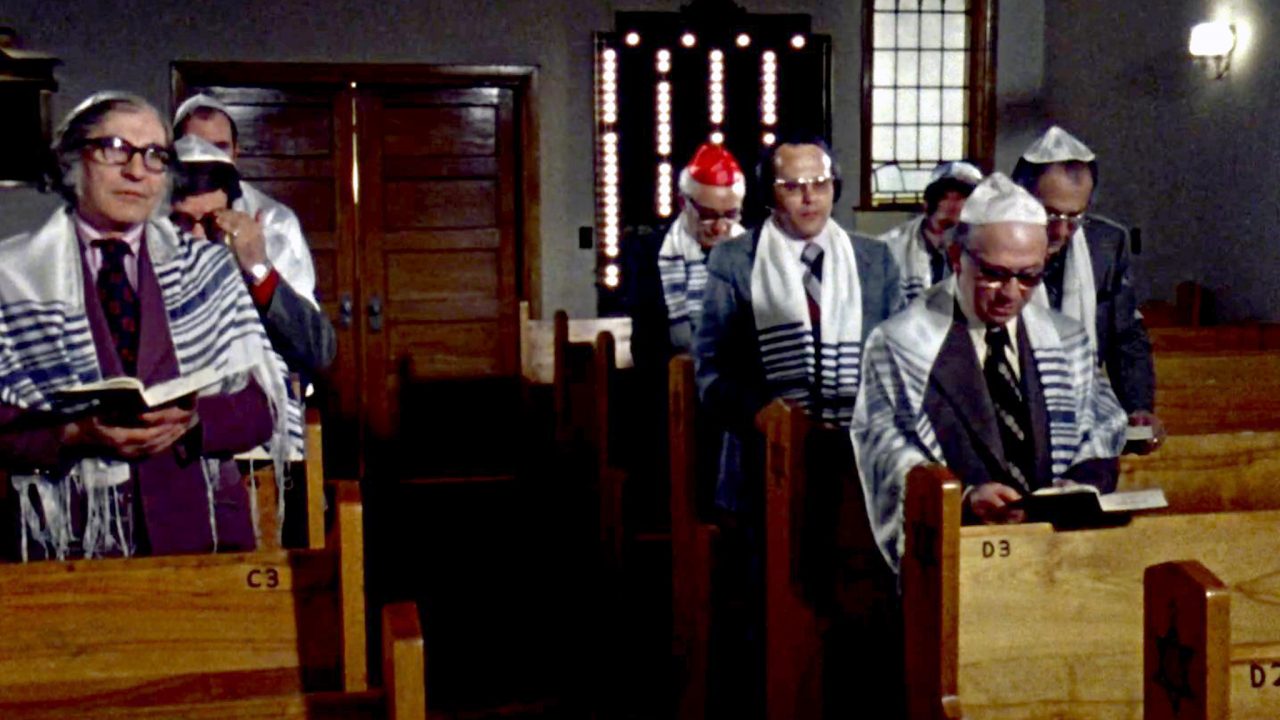
The Jewish Community as seen by the NFB | Curator’s Perspective
The Jewish Community as seen by the NFB | Curator’s Perspective
I often get questions from my colleagues and friends about the different customs and traditions of Judaism. While I am far from being the most knowledgeable on the subject, I try my best to explain the basic laws and traditions associated with being a Jew, some of which are quite complex.
As May is officially Jewish Heritage Month in Canada, I thought I would write about two vastly different films from our collection that focus on the history of Jews in Canada as well as the most important traditions observed by Jews all over the world.
The People of the Book, released in 1973, is a sort of “Judaism 101” in a compact 28 minutes of screen time. We follow two young Jewish people to Northern Ontario to meet Jews in Sudbury, North Bay and Sault Ste. Marie. They explain that it would have been easier to go to a large Canadian city, but they wanted to show how small Jewish communities have managed to survive in Canada. While visiting those cities, they meet several families and explain to us the basic traditions of Judaism, such as the importance of the Sabbath, during which Jews are not permitted to do work of any kind; it is a few hours of tranquility in an otherwise hectic week where they can focus on the family.
The importance of the Torah is also explained. The Torah is basically the Bible, the five books of Moses, the Jewish law that was handed down from Mount Sinai over 3,500 years ago. It is written in Hebrew (from right to left) using a quill on a parchment. No metal used in war (including iron and steel) can touch the Torah, and it must be written by a pious person. The Torah is “the Book” that’s being referred to when the Jews are described as “the People of the Book.”
One of the people they meet in Sudbury, where there were only 40 to 50 Jewish families at the time, is Samuel Rothschild, who, among other things, was the first Jewish player in the NHL. In Sault Ste. Marie, there were so few Jews that occasionally they had to ask Jewish officers at the nearby Kincheloe Air Force Base in Michigan to cross the border and participate in prayers. (In Judaism, it is essential that a minimum of 10 adult men participate in any prayer service. This is called a minyan.)
The People of the Book, Felix Lazarus, provided by the National Film Board of Canada
The People of the Book came about as a result of a new policy by Canada’s Secretary of State in 1971 that sought to support all of the country’s cultures and ethnic groups, in order to help break down discriminatory attitudes and cultural conflicts. In response to this policy, the National Film Board implemented a Multicultural Program in August 1972. Filmmakers from the various cultural groups were brought in and encouraged to make films about their communities. Felix Lazarus proposed this film about Jews in Canada and it was quickly accepted.
The film very neatly encapsulates what it is to be a Jew and the most important traditions and customs.
The Jews of Winnipeg was broadcast as part of the NFB’s West documentary television series on March 13, 1974, across the entire CBC network. It was the 10th episode in that series, and it told the story of the history of Jews in that city. We find out that Jews arrived from England, Germany and the United States in the 19th century, settling in Winnipeg because it was the end of the CPR line. In 1881, there were 33 Jewish families in Manitoba, soon joined by 250 immigrants fleeing the anti-Jewish pogroms that followed the assassination of Czar Alexander II in Russia. Luckily, Sir Alexander T. Galt, who was Canadian High Commissioner in London, strongly advocated that these refugees should be allowed to settle in Canada.
The doc devotes some time to the history of the Jewish community but also talks about the people living there at the time of filming. Several prominent members are highlighted, including comedian David Steinberg, who was visiting his family, and singer and Broadway actress Judith Lander. The film discusses the fact that this community, which never numbered more than 20,000, contributed so much to Manitoba and Winnipeg.
The Jews of Winnipeg, Bill Davies, provided by the National Film Board of Canada
The Jews of Winnipeg garnered good reviews upon its broadcast, including from The Hamilton Spectator, which deemed it “a finely-honed study of a close-knit community,” and The Western Producer, which said it was an “interesting documentary on a particular group of Western Canadians.”
I invite you to watch these two films that shine a light on Jewish life in Canada. If you want to see more films about the contributions of Jewish Canadians, please have a look at our Canadian Jewish Heritage Month channel, here.
PS – Dear readers: After 37 and a half years of loyal service, I am retiring from the NFB. It has been my absolute privilege to write about this incredible institution’s rich collection and to share these thoughts with you. Please stay on the lookout for blog posts by the next English Collection Curator, coming soon.




Thank you, Albert, for such a long career in public service. I always learn from your informative, sometimes hilarious behind-the-scenes stories in these blog posts. Also, I enjoy discovering new (to me) titles or being reminded of old favourites from the rich collection of the NFB. Great that the posts are still available here.